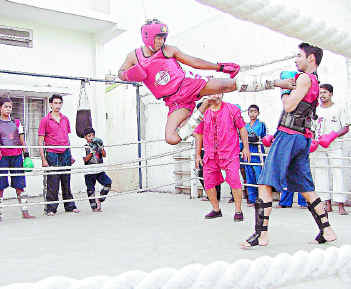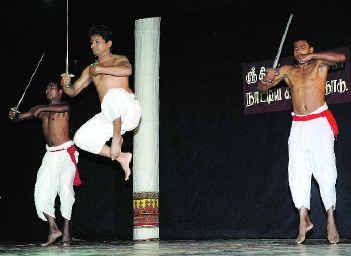Martial arts is a part of India’s ancient culture and a traditional games.Originally a traditional form of martial art that started in South India, and now it has different names and different forms in the culture of the regions in India. Khusti The Indian Wrestling is also a part of Indian Martial arts found throughout the India. Indian martial arts has an important influence in the development of modern Asian martial arts. Nowadays a sense of self-defense and for fitness lots of people are opting for martial arts.As in other respects of Indian culture, Indian martial arts can be roughly divided into northern and southern styles.
Kalarippayattu (asked in UPSC Prelim 2014) :
- Kalarippayattu is a famous Indian martial art from land of attraction Kerala and one of the oldest fighting systems in existence.
- It is practiced in most of the part of south India.
- A kalari is the school or training hall where martial arts are taught.
- It includes strikes, kicks and some weapon based practiced,
- Footwork patterns is most important key in Kalarippayattu.
- It is the best Indian martial art that has been used in many movies to make it popular, like Ashoka and The myth.
 |
Silambam:
- Silambamis, a weapon-based Indian martial art from Tamil Nadu.
- Every states has it own style of martial arts.
- A wide variety of weapons are used in silamban, some of which are not found anywhere else in the world.
- Silambam art also used animal movements of snake, tiger, eagle forms and footwork patterns is play a key role here as well.
- Another part of Silambam is Kuttu varisai, it is the unarmed kind of martial art.


Gatka:
- Gatkais weapon-based Indian martial art basically created by the Sikhs of Punjab.
- There are many weapons used in Gatka like, Stick, Talwar, kirpan and kataar.
- The attacking and defense methods are based upon the positions of the hands feet and nature of weapons used.
- It is also displayed during the different celebrations or at fairs in Punjab.
- The sport form is played by two opponents wielding wooden staves called gatka. These sticks may be paired with a shield. Points are scored for making contact with the stick.
- The other weapons are not used for sparring, but their techniques are taught through forms training.
- It is based on the basic principle of unification of the mind, body and spirit in a rhythm of life to train a saint-soldier to be able to defend himself/herself.


Musti yuddha:
- It is unarmed martial art from the oldest city of India “Varanasi“.
- Technique used in this martial arts are punches, kicks, knees and elbow strikes.
- This style is a complete art of physical, mental and spiritual development.
- This art is very rarely visible but was very popular in middle age.

Thang Ta:
- Thang Ta is popular term for the ancient Manipuri Martial Art also known as HUYEN LALLONG.
- Manipuri martial arts with swords and spears, is a strong yet gracefully sophisticated art.
- The Manipuri art of huyen lalong was once practiced by the state's indigenous hill tribes who would engage in duels governed by strict rules of conduct.
- The armed component called thang-ta is named after the system's main weapons, the thang (sword) and ta (spear). Practitioners spar through cheibi gatka in which a foam sword is used together with a shield.
- Unarmed huyen lalong is called sarit-sarak and is used in conjunction with thang-ta when the fighter loses their weapon


Lathi:
- Lathi is an ancient armed martial art of India.
- It also refers one of the world’s oldest weapons used in martial arts.
- Lathi or stick martial arts practiced in Punjab and Bengal region of India.
- Lathi still remains a popular sport in Indian villages.
 |
Mardani Khel:
- Mardani Khel is an armed method of martial art created by the Maratha.
- This traditional martial art of Maharashtra is practiced in kolhapur.
 |

Pari-khanda:
- Pari-khandaa style of sword and shield fighting from Bihar.
- This art is created by the rajputs.
- Pari-khanda steps and techniques are also used in Chau dance.

=================================================================================
Miscellaneous facts related to the topic :=
- The Vishnu
Purana text describes
dhanuveda as one of the traditional eighteen branches of "applied
knowledge" or upaveda.
- The malla-yuddha (wrestling match) between Bhima and Jarasandha lasts
27 days. Similarly, the dwandayuddha between Parasurama and Bhishma lasts
for 30 days, while that between Krishna and Jambavan lasts
for 28 days. Likewise, the dwandwayudda between Bali and
Dundubhi, a demon in the form of a water
buffalo, lasts for 45 days.
- The Manusmriti tells that if a warrior's topknot
comes loose during such a fight or duel, the opponent must give him time
to bind his hair before continuing.
- Kashmiri swordsmanship is said to have an ancient
history, but it was only much later that it acquired its modern name
of sqay. Sqay survived a decline following
the partition of India by adopting competitive
methodologies of karate and taekwondo. Types of competition include
sparring, breaking, and forms or khawankay. Pracitioners spar
using fake swords called tora which are paired with a
shield. Sparring is point-based, the points being awarded for successful
hits with the tora or with the foot.
 |
- Kick-fighting (aki kiti) is the
preserve of tribes from Nagaland. While the entire Naga population of
northeast India and northwest Myanmar was traditionally known for their
skill with broadswords (dao) and other weapons, disputes among
tribesmen and between tribes were settled with a solely kick-based form of
unarmed fighting. The goal is to either drive the opponent to their knees
or outside of the ring. Only the feet are used to strike, and even
blocking must be done with the legs.
 |
- The Kannada fighting arts are taught exclusively at traditional
training halls or garadi
mane.
Disciplines include unarmed combat (kai varase), staff-fighting (kolu
varase) and sword-fighting (katti varase) among various other
weapons. These are most often seen today only during choreographed demonstrations
at festivals
 |

